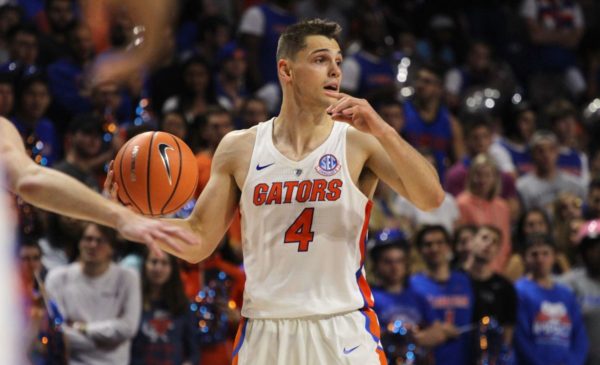Perimeter-Oriented Florida Struggling to Find Inside Consistency
Posted by David Changas on February 7th, 2018In the era of advanced metrics and a discerning understanding of the importance of efficiency in college basketball, it seems unusual to contend that a team’s success is predicated on its ability to knock down the three. But with this year’s Florida team, that belief is an appropriate one. After the Gators’ third consecutive SEC loss on Saturday – a 68-50 drubbing at the hands of Alabama – it is all too apparent that Florida’s inconsistency on the offensive end is the corresponding reason for its overall inconsistency. The Crimson Tide outscored Florida 41-17 in the second half in what was the Gators’ second straight conference loss at home and whopping fifth overall in Gainesville. Remember when they were ranked as high as sixth in the AP poll earlier this season?

Rice transfer Egor Koulechov has been great for Florida, but a limited inside game may limit the Gators’ postseason prospects. (Alan Alvarez/Alligator Sports)
A common theme in each of Florida’s eight defeats has been its inability to knock down the perimeter jumper. The Gators are shooting 29.5 percent from beyond the arc in those losses while they are at 41.9 percent in their 15 wins. In other words, when things are going well for Florida, they go really well. But when those outside shots are not falling, ugly and somewhat inexplicable ones – such as Saturday’s beatdown, as well as home losses to Loyola (Chicago) and South Carolina – occur. This significant disparity from three-point range has led to an overall effective field goal percentage of 50.9 percent, which ranks 171st in the nation. While the ability to make shots and score in bunches will still make the Gators a dangerous team in March, it also puts them at significant risk of being an early out in postseason play.
The predicament that coach Mike White finds his team in should not be surprising, however, when you consider that his club’s offensive output is far too reliant on its guards. The quartet of Jalen Hudson, Egor Koulechov, Chris Chiozza and KeVaughn Allen, each of whom averages at least 11.5 points per game, has been terrific most of the season. But with any real inside presence to balance their attack, the Gators have been forced to rely upon those four players way too much. Senior center John Egbunu along with freshmen Chase Johnson and Isaiah Stokes have combined to play 34 minutes this season. In their absence, White has been unable to find anyone on the roster ready to step up and fill the void. Florida has therefore understandably also struggled on the boards all season long, making it a team that is relatively easy to score on — the Gators currently rank 68th in KenPom’s Adjusted Defensive Efficiency metric.
At this late point in the season, it seems unlikely that White will be able to count on any production from Egbunu or the two big freshmen. It is more likely that what we have seen from Florida through its first 23 games is what we will get the rest of the way. The Gators have a relatively manageable stretch of games over the next couple of weeks, but they will need to get as many wins as possible against some of the league’s lower-echelon teams before finishing with a trip to Tennessee, a home game with Auburn, a rematch at Alabama, and their home finale against Kentucky. Ultimately, Florida remains a scary team that could become very dangerous in March, but the Gators’ heavy reliance upon perimeter success makes another deep NCAA Tournament run appear unlikely.










































